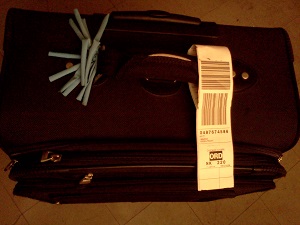By Holly Nagel
Travel Tips: Know your Bags
Now boarding!
I’ve flown over 1,000 times.
In another life I was once a flight attendant. I also love to travel and I’ve collected a few tips for the newbie air traveler and may even offer something useful for the seasoned traveler in the hopes of saving you a lot of undue grief, tears and hidden fees.
Yes, tears. I mean it. I’ve watched grown men and women (myself included!) crumple at the feet of the TSA agent and airline clerks that enforce the rules. There is no discussion when dealing with them. Only salty tears.
Knowing your bags can save your life. Okay, okay, maybe that’s a bit dramatic, but knowing your airline’s luggage limitations can actually alleviate stress which in turn can add years to your life. Why set yourself up for major aggravation? Be proactive. Start by always checking the requirements of these three places: your airline, the TSA (Transportation Security Administration), and if you’re leaving the US, check with your destination country.
1) Size matters.
That means knowing weight and measurements for actual checked luggage and carryon bags. (Yes, get out that tape measure and scale!) Some airlines have a scale and even a steel frame template that you can place your luggage and/or carryon inside of to be sure it meets their requirements, but why wait until you’re at the airport? Sure, some clerks may let bags go through, if the plane has extra space, but don’t take the chance.
2) Bags and Tags.
–Be sure your routing tags have the correct 3-letter destination airport on them.
–Mark your luggage so it can be easily identifiable on the baggage carousel and in the overhead bin. Do you know how many black bags there are? Lots. I know because mine are black. Some put a ribbon or colorful tag on them. I put a small pompon of uninflated balloons on the handle and all my family’s luggage is marked the same way.
–Have your ID info on the inside of your baggage. Lost luggage happens, but it can also be found. Give a phone number at the very least.
— Sturdy bag design in basic neutrals are what I would suggest. These bags could have thousands of pounds on them at a time, will get wet, scratched and beat up. Really beat up. The most ideal luggage has a hard outer shell and wheels. Airlines may not discuss some of the nitty gritty of baggage damage, but designer bags or conspicuously expensive bags are not something I would recommend for many reasons. Need to lock it? Purchase the locks approved by TSA. These can be opened by TSA personnel with a universal master key and if your luggage needs to be inspected, then TSA can open it without cutting your lock. Some airlines also allow wrapping your bags in clear plastic film to dissuade others from possibly stealing from it or putting something into it.
3) Security and the Carryon.
Accessibility is the word. It is the key, the secret, to travelling with at least a modicum of ease, especially through security. If your purse is inside the carryon, or you don’t carry a purse, place ID, boarding pass and ticket in a zippered outer pocket that is accessible, as in easily reachable. Not the zippered pouch inside your purse in the velcroed section of your carryon. (After checking in through security, you can place ID’s back in your purse/wallet).
–The security line. Some terminals get very crowded and busy, so use the restroom first because lines can get long. When standing in the security check line, listen up. Rules can change at any time and the TSA agents routinely holler out their specific instructions as you wait. Often at the busier terminals there is a certain amount of speed and efficiency involved. No worries. Take a breath, observe others, listen up, and you’ll get through fine. You can always ask a question if you’re unsure. Most of the speed has to do with getting all your stuff off of you, into trays, onto the conveyor belt, then walking through the metal detector and Xray machine.
–Placement. I always prefer my carryon under the seat in front of me so I have easy access and I don’t have to get up to retrieve things from the overhead bin. This can be a major drag especially if you’re not on the isle. BTW, in some planes, the emergency exit row often has no under the seat storage area, but will often have more leg room.
–Inside the carryon. I always include electronic devices, snacks, empty water bottle I can fill after going through security, reading and writing material (if not on a device), a shawl/pashmina/lightweight crushable jacket as the plane tends to get chilly; inflatable neck pillow. Yeah, yeah I used to despise those pillows, too, until I tried one and can now rest much more comfortably without leaning on my neighbor or having a lollygagging head, which would often end up on my neighbor.
I’m not one to embarrass easily, but waking up on a stanger’s arm (I’m too short for anyone’s shoulder) rates as a most embarrassing act, right after walking around with toilet paper hanging out of my pants. Which I have also done and which is another whole story. Some travelers always pack their toothbrush, a change of underwear and similar essentials should their luggage get lost en route. They’ve obviously had lost luggage before. Me? Not yet, but I don’t want to jinx it by preparing too much.
Soon to come: Part 2: Packing; Part 3: At the Airport & Boarding



No comments yet.